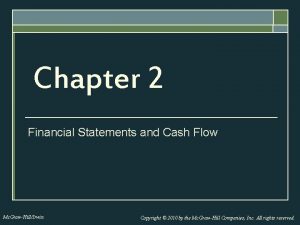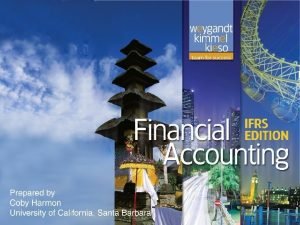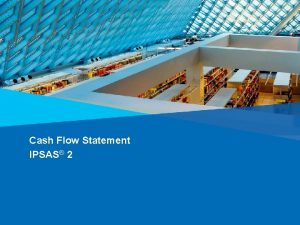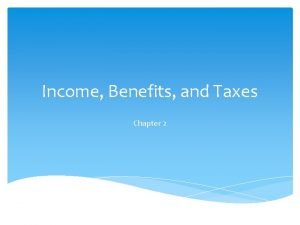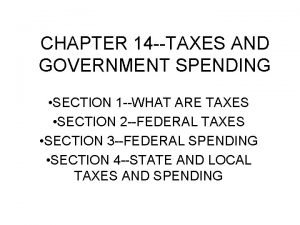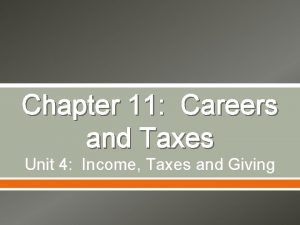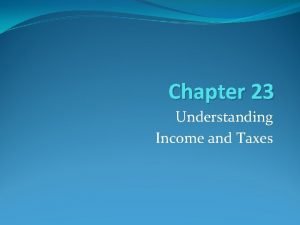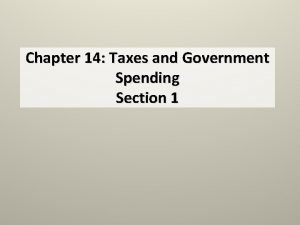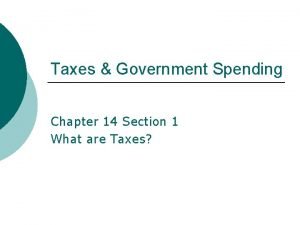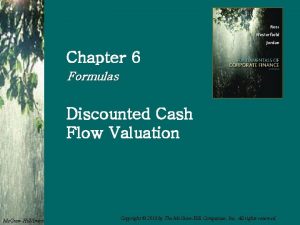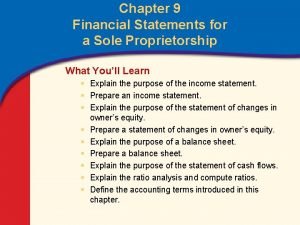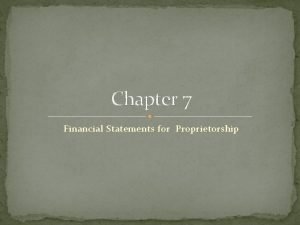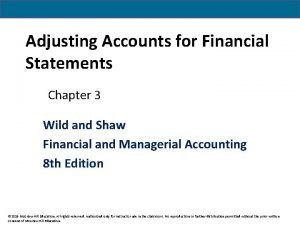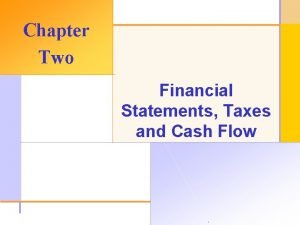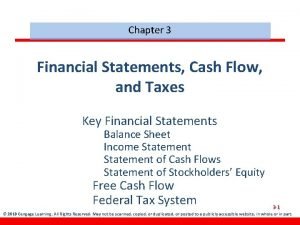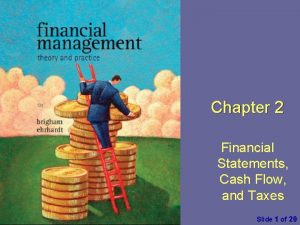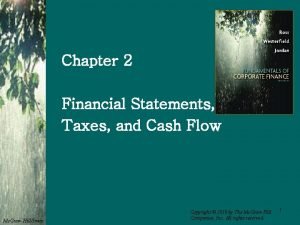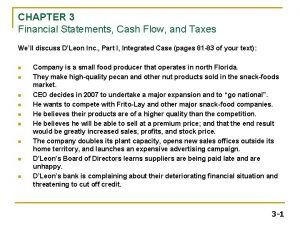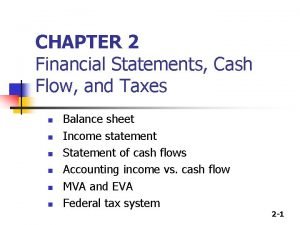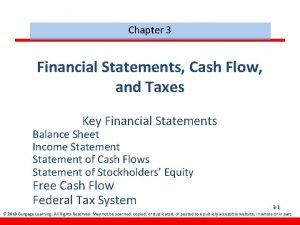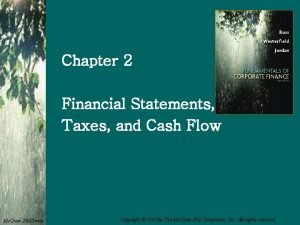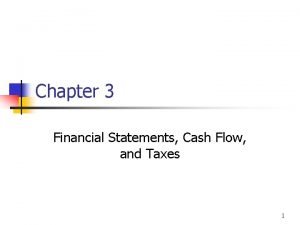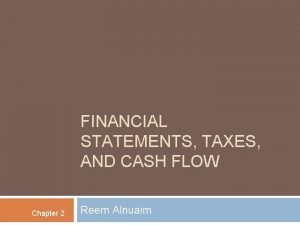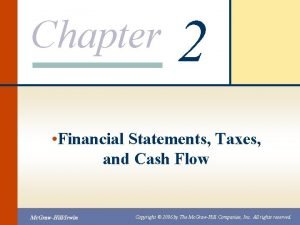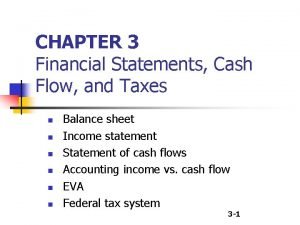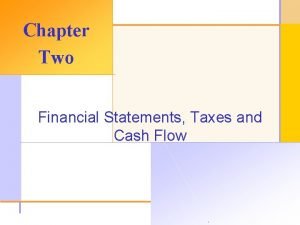CHAPTER 3 Financial Statements Cash Flow and Taxes

















- Slides: 17

CHAPTER 3 Financial Statements, Cash Flow, and Taxes n Key Financial Statements n n n Balance sheet Income statements Statement of retained earnings Statement of cash flows Accounting income vs. cash flows 3 -1

The annual report n n Balance sheet – provides a snapshot of a firm’s financial position at one point in time. Income statement – summarizes a firm’s revenues and expenses over a given period of time. Statement of retained earnings – shows how much of the firm’s earnings were retained, rather than paid out as dividends. Statement of cash flows – reports the impact of a firm’s activities on cash flows over a given period of time. 3 -2

Balance sheet: Assets Cash A/R Inventories Total CA Gross FA Less: Dep. Net FA Total Assets 2005 7, 282 632, 160 1, 287, 360 1, 926, 802 1, 202, 950 263, 160 939, 790 2, 866, 592 2004 57, 600 351, 200 715, 200 1, 124, 000 491, 000 146, 200 344, 800 1, 468, 800 3 -3

Balance sheet: Liabilities and Equity 2005 Accts payable 524, 160 Notes payable 636, 808 Accruals 489, 600 Total CL 1, 650, 568 Long-term debt 723, 432 Common stock 460, 000 Retained earnings 32, 592 Total Equity 492, 592 Total L & E 2, 866, 592 2004 145, 600 200, 000 136, 000 481, 600 323, 432 460, 000 203, 768 663, 768 1, 468, 800 3 -4

Income statement Sales COGS Other expenses EBITDA Depr. & Amort. EBIT Interest Exp. EBT Taxes Net income 2005 6, 034, 000 5, 528, 000 519, 988 (13, 988) 116, 960 (130, 948) 136, 012 (266, 960) (106, 784) (160, 176) 2004 3, 432, 000 2, 864, 000 358, 672 209, 328 18, 900 190, 428 43, 828 146, 600 58, 640 87, 960 3 -5

Other data No. of shares EPS DPS Stock price Lease pmts 2005 100, 000 -$1. 602 $0. 11 $2. 25 $40, 000 2004 100, 000 $0. 88 $0. 22 $8. 50 $40, 000 3 -6

Statement of Retained Earnings (2005) Balance of retained $203, 768 earnings, 12/31/04 Add: Net income, 2005 (160, 176) (11, 000) Less: Dividends paid Balance of retained $32, 592 earnings, 12/31/05 3 -7

Statement of Cash Flows (2005) OPERATING ACTIVITIES Net income Add (Sources of cash): Depreciation Increase in A/P Increase in accruals Subtract (Uses of cash): Increase in A/R Increase in inventories Net cash provided by ops. (160, 176) 116, 960 378, 560 353, 600 (280, 960) (572, 160) (164, 176) 3 -8

Statement of Cash Flows (2005) L-T INVESTING ACTIVITIES Investment in fixed assets (711, 950) FINANCING ACTIVITIES Increase in notes payable Increase in long-term debt Payment of cash dividend Net cash from financing 436, 808 400, 000 (11, 000) 825, 808 NET CHANGE IN CASH (50, 318) Plus: Cash at beginning of year Cash at end of year 57, 600 7, 282 3 -9

What can you conclude about D’Leon’s financial condition from its statement of CFs? n n n Net cash from operations = -$164, 176, mainly because of negative NI. The firm borrowed $825, 808 to meet its cash requirements. Even after borrowing, the cash account fell by $50, 318. 3 -10

Did the expansion create additional net operating after taxes (NOPAT)? NOPAT = EBIT (1 – Tax rate) NOPAT 05 = -$130, 948(1 – 0. 4) = -$130, 948(0. 6) = -$78, 569 NOPAT 04 = $114, 257 3 -11

Does D’Leon pay its suppliers on time? n n n Probably not. A/P increased 260%, over the past year, while sales increased by only 76%. If this continues, suppliers may cut off D’Leon’s trade credit. 3 -12

Does it appear that D’Leon’s sales price exceeds its cost per unit sold? n NO, the negative NOPAT and decline in cash position shows that D’Leon is spending more on its operations than it is taking in. 3 -13

What if D’Leon’s sales manager decided to offer 60 -day credit terms to customers, rather than 30 -day credit terms? n n If competitors match terms, and sales remain constant … n A/R would é n Cash would ê If competitors don’t match, and sales double … n Short-run: Inventory and fixed assets éto meet increased sales. A/R é, Cash ê. Company may have to seek additional financing. n Long-run: Collections increase and the company’s cash position may improve. 3 -14

How did D’Leon finance its expansion? n n D’Leon financed its expansion with external capital. D’Leon issued long-term debt which reduced its financial strength and flexibility. 3 -15

What happens if D’Leon depreciates fixed assets over 7 years (as opposed to the current 10 years)? n n n No effect on physical assets. Fixed assets on the balance sheet would decline. Net income would decline. Tax payments would decline. Cash position would improve. 3 -16

Corporate and Personal Taxes n n n Both have a progressive structure (the higher the income, the higher the marginal tax rate). Corporations n Rates begin at 15% and rise to 35% for corporations with income over $10 million, although corporations with income between $15 million and $18. 33 million pay a marginal tax rate of 38%. n Also subject to state tax (around 5%). Individuals n Rates begin at 10% and rise to 35% for individuals with income over $319, 100. n May be subject to state tax. 3 -17
 Cffa finance formula
Cffa finance formula Cash flow to creditors is equal to
Cash flow to creditors is equal to Cash is current asset or not
Cash is current asset or not Ipsas 2 summary
Ipsas 2 summary Chapter 3 analysis of financial statements
Chapter 3 analysis of financial statements Financial statements and ratio analysis chapter 3
Financial statements and ratio analysis chapter 3 Chapter 2 income benefits and taxes
Chapter 2 income benefits and taxes Chapter 14: taxes and government spending section 1
Chapter 14: taxes and government spending section 1 Foundationsu.com disc
Foundationsu.com disc Chapter 23 understanding income and taxes
Chapter 23 understanding income and taxes Chapter 14 taxes and government spending
Chapter 14 taxes and government spending Chapter 14 taxes and government spending
Chapter 14 taxes and government spending Cash-in cash-out
Cash-in cash-out Chapter 6 discounted cash flow valuation
Chapter 6 discounted cash flow valuation Adjusting accounts for financial statements chapter 3
Adjusting accounts for financial statements chapter 3 Sole proprietorship income statement
Sole proprietorship income statement Chapter 7 financial statements for a proprietorship
Chapter 7 financial statements for a proprietorship Adjusting accounts for financial statements
Adjusting accounts for financial statements

